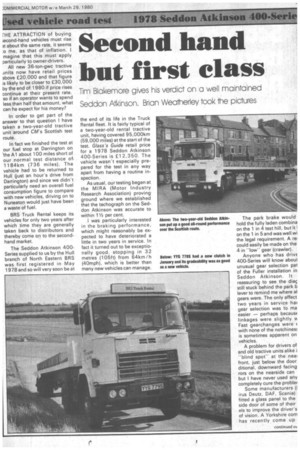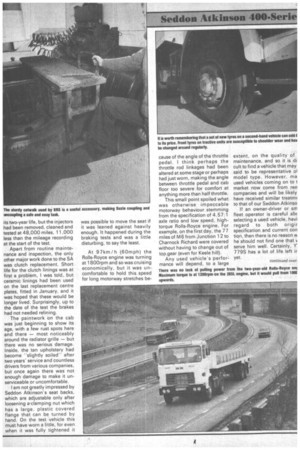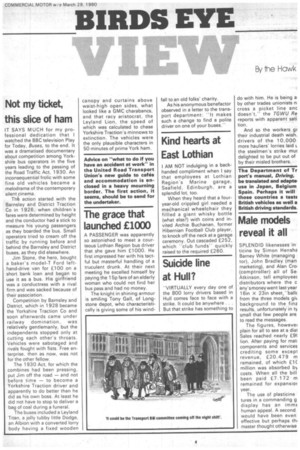Second hand but first class
Page 39

Page 40

Page 41

Page 43

If you've noticed an error in this article please click here to report it so we can fix it.
Tim Blakemore gives his verdict on a well maintained Seddon Atkinson, Brian Weatherley took e pictures
EHE ATTRACTION of buying ;econd-hand vehicles must rise It about the same rate, it seems .o me, as that of inflation. I magine that this must apply particularly to owner-drivers.
All new 36-ton-gwc tractive inits now have retail prices 3bove £20,000 and that figure is likely to be closer to £30,000 by the end of 1980 if price rises continue at their present rate. so if an operator wants to spend less than half that amount, what can he expect for his money?
In order to get part of the answer to that question I have taken a two-year-old tractive unit around CM's Scottish test route.
In fact we finished the test at our fuel stop at Darrington on the Al about 100 miles short of our normal test distance of 1184km (736 miles). The vehicle had to be returned to Hull (just an hour's drive from Darrington) and since we didn't particularly need an overall fuel consumption figure to compare with new vehicles, driving on to Nuneaton would just have been a waste of fuel.
8FIS Truck Rental keeps its vehicles for only two years after which time they are generally taken back to distributors and thereby come on to the secondhand market.
The Seddon Atkinson 400Series supplied to us by the Hull branch of North Eastern BRS was first registered in May 1978 and so will very soon be at the end of its life in the Truck Rental fleet. It is fairly typical of a two-year-old rental tractive unit, having covered 95,000km (59,000 miles) at the start of the test. Glass's Guide retail price for a 1978 Seddon Atkinson 400-Series is £12,350. The vehicle wasn't especially prepared for the test in any way apart from having a routine inspection.
As usual, our testing began at the MIRA (Motor Industry Research Association) proving ground where we established that the tachograph on the Seddon Atkinson was accurate to within 11/2 per cent.
I was particularly interested in the braking performance, which might reasonably be expected to have deteriorated a little in two years in service. In fact it turned out to be exceptionally good, stopping in 32 metres (105ft) from 64km /h (40mph), which is better than many new vehicles can manage. The park brake would hold the fully laden combina on the 1 in 4 test hill, but it I on the 1 in 5 and was well wi the legal requirement. A re: could easily be made on the 4 in "low" gear (crawler).
Anyone who has drivE 400-Series will know abour unusual gear selection pat of the Fuller installation in Seddon Atkinson. It reassuring to see the diac_ still stuck behind the park b lever to remind me where al gears were. The only affect two years in service ha( gear selection was to ma easier — perhaps becausE linkages were slightly vi Fast gearchanges were E with none of the notchinesf. is sometimes apparent on vehicles.
A problem for drivers of and old tractive units alike i ''blind spotat the neai front, just below the door ditional, downward facing rors on the nearside can but I have never used any completely cure the probler
Some manufacturers (I irus Deutz, DAF, Scania) fitted a glass panel to the side door of some of their els to improve the driver's of vision, A Yorkshire corn has recently come up
idea that can be used on any icle — the Vangard wideN window lens (CM TechniNews, January 26, 1980). test of the Seddon Atkinson e us an opportunity to try
Aeasuring 203mm (Sin) X 3mm (6in), the Vangard 8 is smallest of the range and is immended for use on tracunits. It is flexible and is to the nearside window )Iy by cleaning the glass, ing it and applying the lens. t the end of the three-day our lens was still firmly in a and did not move when rvindow was wound up and n a few times. The photoh shows how effective it is ducing the kerbside "blind spot," while still lea‘iing most of the window through which to get a normal view.
Fitting it as close as possible to the base of the window makes it most effective in extending the driver's field of vision towards the nearside front wheel and thus improving the chances of spotting a cyclist or pedestrian who may be close in on that side.
While it would not be fair to make any direct comparisons between the Seddon Atkinson's fuel consumption and any new vehicle that CM has tested because, as I mentioned earlier, the SA wasn't prepared in any way for the test, we were nevertheless interested in the mpg
figures for the two-year-old tractive unit could achieve. The effect of terrain on fuel consumption can be clearly seen from the difference between the worst section (Rochester to Neville's Cross) and the best (Neville's Cross to Darrington); 4.77mpg is a measure of the severity of the A68 section where both vehicles and drivers always have to work hard.
Age seemed to have no effect on the SA's hill-climbing ability, for even the most severe gradient did not need crawler gear and it is worth noting that the time for climbing Carter Bar was exactly the same as that achieved by Graham Montgomerie in a new Rolls-powered Seddon Atkinson in 1977.
The overall fuel consumption figure would have been, slightly better, I think, if the vehicle had not developed two minor defects during the course of the test. A slight air leak on the brake system, not noticeable during normal operation, drained one of the air tanks on each overnight stop and this meant that the engine had to be run each morning to build up the air pressure.
The second defect was a slight fuel leak from the lift pump, which I noticed when we stopped at Gretna at the start of the second day. We had this repaired at the nearest SIRS de pot at Dumfries before we continued northwards (it was just a loose union on a pipe), starting the fuel and time checks again from Gretna as normal.
Taking these factors into account, the overall figure of 6.93mpg is creditable. The injection pump on the Eagle engine had not had any repairs in its two-year life, but the injectors had been removed, cleaned and tested at 48,000 miles, 11,000 less than the mileage recording at the start of the test.
Apart from routine maintenance and inspection, the only other major work done to the SA was clutch replacement. Short life for the clutch linings was at first a problem, I was told, but ceramic linings had been used on the last replacement centre plates, fitted in January, and it was hoped that these would be longer lived. Surprisingly, up to the date of the test the brakes had not needed relining.
The paintwork on the cab was just beginning to show its age, with a few rust spots here and there — most noticeably around the radiator grille — but there was no serious damage. Inside, the tan upholstery had become "slightly soiledafter two years' service and countless drivers from various companies, but once again there was not enough damage to make it unserviceable or uncomfortable.
I am not greatly impressed by Seddon Atkinson's seat backs, which are adjustable only after loosening a'clamping nut which has a large, plastic covered flange that can be turned by hand. On the test vehicle this must have worn a little, for even when it was fully tightened it was possible to move the seat if it was leaned against heavily enough. It happened during the braking tests and was a little disturbing, to say the least.
At 97km / h (60mph) the Rolls-Royce engine was turning at 1800rpm and so was cruising economically, but it was uncomfortable to hold this speed for long motorway stretches be
cause of the angle of the throttle pedal. I think perhaps the throttle rod linkages had been altered at some stage or perhaps had just worn, making the angle between throttle pedal and cab floor too severe for comfort at anything more than half throttle.
This small point spoiled what was otherwise impeccable motorway behaviour stemming from the specification of 4.57:1 axle ratio and low speed, hightorque Rolls-Royce engine. For example, on the first day, the 77 miles of M6 from Junction 12 to Charnock Richard were covered without having to change out of top gear (even for Keele hill).
Any used vehicle's perfor: mance will depend, to a large extent, on the quality of maintenance, and so it is di cult to find a vehicle that may said to be representative ol model type. However, ma used vehicles coming on to t market now come from ren companies and will be likely have received similar treatmr to that of our Seddon Atkinso If an owner-driver or sm fleet operator is careful alp( selecting a used vehicle, havi regard to both origir specification and current con tion, then there is no reason w he should not find one that ), serve him well. Certainly, Y' 779S has a lot of life left ir
Not my ticket, this slice of ham
IT SAYS MUCH for my professional dedication that I watched the BBC television Play for Today, Buses, to the end. It was a dramatised documentary about competition among Yorkshire bus operators in the five years leading to the passing of the Road Traffic Act, 1930. An inconsequential frolic with some fine old vehicles became a melodrama of the contemporary silent cinema.
The action started with the Barnsley and District Traction Co in 1926, when children's fares were determined by height and the conductor had a stick to measure his young passengers as they boarded the bus. Small operators tried to cream off the traffic by running before and behind the Barnsley and District buses, as they did elsewhere.
Jim Stone, the hero, bought a baker's model-T Ford lefthand-drive van for £100 on a short bank loan and began to use it as a bus. His girlfriend was a conductress with a rival firm and was sacked because of their association.
Competition by Barnsley and District, which in 1928 became the Yorkshire Traction Co and soon afterwards came under railway domination, was relatively gentlemanly, but the independents stopped only at cutting each other's throats_ Vehicles were sabotaged and rivals fought with fists. Free enterprise, then as now, was not for the other fellow.
The 1930 Act, for which the combines had been pressing, put Jim off the road — and not before time — to become a Yorkshire Traction driver and apparently to do better than he did as his own boss. At least he did not have to stop to deliver a bag of coal during a funeral.
The buses included a Leyland Titan, a jolly tubby little Dodge, an Albion with a converted lorry body having a fixed wooden canopy and curtains above waist-high open sides, what looked like a GMC charabancs, and that racy aristocrat, the Leyland Lion, the speed of which was calculated to chase Yorkshire Traction's minnows to extinction. The vehicles were the only plausible characters in 50 minutes of prime York ham.




























































































































